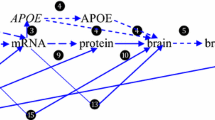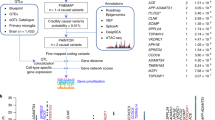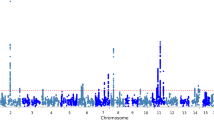Abstract
The aims of this study were to identify candidate single nucleotide polymorphisms (SNPs) and mechanisms of Alzheimer’s disease (AD) and to generate SNP to gene to pathway hypotheses. An AD genome-wide association study (GWAS) dataset that included 370,542 SNPs in 1,000 cases and 1,000 controls of European descent was used in this study. Identify Candidate Causal SNPs and Pathway (ICSNPathway) analysis was applied to the GWAS dataset. ICSNPathway analysis identified 3 candidate SNPs and 2 pathways, which provided 3 hypothetical biological mechanisms. The strongest hypothetical biological mechanism was rs8076604 [non-synonymous coding (deleterious)] to MYO18A to negative regulation of programmed cell death [nominal P < 0.001, false discovery rate (FDR) <0.043]. The second was rs2811226 (regulatory region) to ANXA1 to negative regulation of programmed cell death (nominal P < 0.001, FDR 0.043). The third was rs3734166 (non-synonymous coding) to CDC25C to M phase of the mitotic cell cycle (nominal P < 0.001, FDR 0.049). By applying the ICSNPathway analysis to the AD GWAS meta-analysis data, three candidate SNPs, three genes (MYO18A, ANXA1, CDC25C), 2 pathways involving negative regulation of programmed cell death and 1 pathway involving the M phase of the mitotic cell cycle were identified, which may contribute to AD susceptibility.

Similar content being viewed by others
References
Bertram L, Tanzi RE (2012) The genetics of Alzheimer’s disease. Prog Mol Biol Transl Sci 107:79–100
Li H, Wetten S, Li L, St Jean PL, Upmanyu R, Surh L et al (2008) Candidate single-nucleotide polymorphisms from a genomewide association study of Alzheimer disease. Arch Neurol 65(1):45–53
Harold D, Abraham R, Hollingworth P, Sims R, Gerrish A, Hamshere ML et al (2009) Genome-wide association study identifies variants at CLU and PICALM associated with Alzheimer’s disease. Nat Genet 41(10):1088–1093
Manolio TA (2010) Genomewide association studies and assessment of the risk of disease. N Engl J Med 363(2):166–176
Johnson AD, O’Donnell CJ (2009) An open access database of genome-wide association results. BMC Med Genet 10:6
Sherva R, Tripodis Y, Bennett DA, Chibnik LB, Crane PK, de Jager PL et al (2014) Genome-wide association study of the rate of cognitive decline in Alzheimer’s disease. Alzheimers Dement 10(1):45–52
Seshadri S, Fitzpatrick AL, Ikram MA, DeStefano AL, Gudnason V, Boada M et al (2010) Genome-wide analysis of genetic loci associated with Alzheimer disease. JAMA 303(18):1832–1840
Hong MG, Alexeyenko A, Lambert JC, Amouyel P, Prince JA (2010) Genome-wide pathway analysis implicates intracellular transmembrane protein transport in Alzheimer disease. J Hum Genet 55(10):707–709
Liu G, Jiang Y, Wang P, Feng R, Jiang N, Chen X et al (2012) Cell adhesion molecules contribute to Alzheimer’s disease: multiple pathway analyses of two genome-wide association studies. J Neurochem 120(1):190–198
Borovecki F, Klepac N, Muck-Seler D, Hajnsek S, Mubrin Z, Pivac N (2011) Unraveling the biological mechanisms in Alzheimer’s disease–lessons from genomics. Prog Neuropsychopharmacol Biol Psychiatry 35(2):340–347
Wang K, Li M, Hakonarson H (2010) Analysing biological pathways in genome-wide association studies. Nat Rev Genet 11(12):843–854
Lee YH, Song GG (2012) Pathway analysis of genome-wide association studies on uric acid concentrations. Hum Immunol 73(8):805–810
Zhang K, Chang S, Cui S, Guo L, Zhang L, Wang J (2011) ICSNPathway: identify candidate causal SNPs and pathways from genome-wide association study by one analytical framework. Nucleic Acids Res 39:W437–W443
Kanehisa M, Goto S, Furumichi M, Tanabe M, Hirakawa M (2010) KEGG for representation and analysis of molecular networks involving diseases and drugs. Nucleic Acids Res 38:D355–D360
Ashburner M, Ball CA, Blake JA, Botstein D, Butler H, Cherry JM et al (2000) Gene ontology: tool for the unification of biology. The gene ontology consortium. Nat Genet 25(1):25–29
Johnson AD, Handsaker RE, Pulit SL, Nizzari MM, O’Donnell CJ, de Bakker PI (2008) SNAP: a web-based tool for identification and annotation of proxy SNPs using HapMap. Bioinformatics 24(24):2938–2939
Zeggini E, Ioannidis JP (2009) Meta-analysis in genome-wide association studies. Pharmacogenomics 10(2):191–201
Elbers CC, van Eijk KR, Franke L, Mulder F, van der Schouw YT, Wijmenga C et al (2009) Using genome-wide pathway analysis to unravel the etiology of complex diseases. Genet Epidemiol 33(5):419–431
Fridley BL, Biernacka JM (2011) Gene set analysis of SNP data: benefits, challenges, and future directions. Eur J Hum Genet 19(8):837–843
Pedroso I, Breen G (2011) Gene set analysis and network analysis for genome-wide association studies. Cold Spring Harb Protoc 2011(9):pdb.top065581
Kim HR, Park MK, Cho ML, Kim KW, Oh HJ, Park JS et al (2010) Induction of macrophage migration inhibitory factor in ConA-stimulated rheumatoid arthritis synovial fibroblasts through the P38 map kinase-dependent signaling pathway. Korean J Intern Med 25(3):317–326
Hsu RM, Tsai MH, Hsieh YJ, Lyu PC, Yu JS (2010) Identification of MYO18A as a novel interacting partner of the PAK2/betaPIX/GIT1 complex and its potential function in modulating epithelial cell migration. Mol Biol Cell 21(2):287–301
McArthur S, Cristante E, Paterno M, Christian H, Roncaroli F, Gillies GE et al (2010) Annexin A1: a central player in the anti-inflammatory and neuroprotective role of microglia. J Immunol 185(10):6317–6328
Chang KH, Vincent F, Shah K (2012) Deregulated Cdk5 triggers aberrant activation of cell cycle kinases and phosphatases inducing neuronal death. J Cell Sci 125(21):5124–5137
Acknowledgments
The authors gratefully acknowledge investigators for sharing their valuable GWAS data.
Conflict of interest
The authors declare that they have no vested interest that could be construed to have inappropriately influenced this study.
Author information
Authors and Affiliations
Corresponding author
Rights and permissions
About this article
Cite this article
Lee, Y.H., Song, G.G. Genome-wide pathway analysis of a genome-wide association study on Alzheimer’s disease. Neurol Sci 36, 53–59 (2015). https://doi.org/10.1007/s10072-014-1885-3
Received:
Accepted:
Published:
Issue Date:
DOI: https://doi.org/10.1007/s10072-014-1885-3




